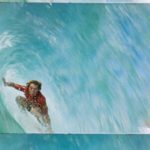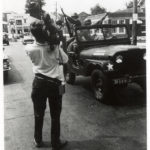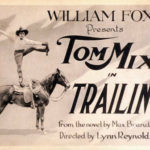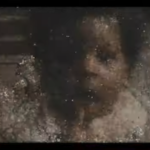What is the Artwork?
Examining Works of Media Art at the University of Amsterdam’s Erfgoedlab
By Caylin Smith
The thirteenth edition of the University of Amsterdam’s ErfgoedLab (HeritageLab) took place throughout June and allowed students in cultural heritage master’s programs to create conservation models for three media artworks. A non-profit organization, the ErfgoedLab is located within the Special Collections and the Allard Pierson Museum building, where it functions as a studio, workshop, and exhibition area.
The Media Art Conservation and Restoration Workshop took place through cooperation with the University of Amsterdam and the Netherlands Institute for Media Art (NIMk). The mentors for the participating students were Jan Bolten, Project Coordinator at the ErfgoedLab; Evelyne Snijders, conservator of modern and contemporary art at the Stedelijk Museum; Gaby Wijers, NIMk’s head of collections; and Sanneke Stigter, curator of contemporary art and lecturer at the UvA.
Whereas the knowledge acquired throughout their degrees and guidance from these professionals helped the students discuss conservation concerns, there was still much deliberation in regards to suggesting solutions that had long-term effects. This was especially because conserving and exhibiting works of media art present problems that are more complicated than for other types of artworks. With a painting, for example, the conservator and curator know both the medium and the carrier. These inherent characteristics are not always easy to define with works of media art, especially since they commonly involve elements of interactivity, networks, computation, or possibly all three.
The term media art is itself problematic and becomes even more so when the word ‘new’ is attached. Beryl Graham and Sarah Cook have noted this problem in their book Rethinking Curating: “Some part of new media will always be in emergence, and even the historical frames of understanding what is ‘new’ will change.” The expanding field of media art is therefore malleable on many levels.
The students examined works by three Dutch media artists: SERVAAS’ Pfft… (1982), eddie d’s Toonbeeldklavier (1993) and its use in performances, and Monique Toebosch’s Painthouse (1981).
Sjoukje van der Laan of the Conservation and Restoration program and I were assigned to Pfft… a work of video art produced by SERVAAS at the beginning of the 1980s. Pfft… is commonly regarded as SERVAAS’ first major contribution to the field, though his career as an artist began much earlier: he started to paint in the 1970s, but soon found that this medium did not allow him to convey a strong sense of movement. He then switched to film and soon experimented with video after finding this former medium too costly.
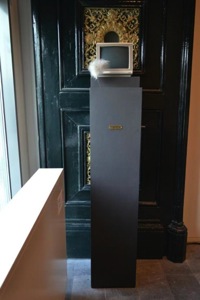
It was with Pfft… that SERVAAS began experimenting with pneumatic equipment and it is also one of his more sophisticated pneumatic works. The exterior consists of a video monitor that stands on top of a tall black pedestal with a feather anchored in front of the screen. The video playing depicts a close-up of SERVAAS’ mouth as he blows toward the screen and the work is constructed so that air from a compressor moves the feather every time SERVAAS blows.
Conserving and exhibiting Pfft… involved addressing both its appearance and technical equipment. For example, a television monitor was initially used, which added a “live” element to the work, but it was later replaced with a regular monitor. This latter type has since been used and updating it to a high-definition monitor would not only change the appearance, but also the meaning of the work. This factor was already altered shortly after the work was produced in 1982: the original video shows SERVAAS’ entire face, yet the second version only shows a close-up of his mouth.
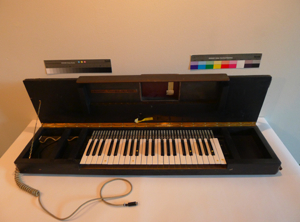
The issues provoked by the other two works proved to be more conceptual in nature. Marleen Wagenaar of the Conservation and Restoration program examined the Toonbeeldklavier, a keyboard developed by Shaun O’Neil and Montevideo to which eddie d’s visuals and sounds were programmed. Eddie d’s oeuvre consists of photographs, videopoems, and video and computer installations. Developing a relationship between image and sound is commonly found throughout his works.
This relationship was especially demonstrated by eddie d’s contribution to Sound Movie, a 1994 concert for which Jaap Derksen composed music to be performed by a six-person orchestra. This concert was originally performed at the Stedelijk Museum and then went on tour throughout Europe. Sound Movie was later re-imagined as H2Oor for the opening of the Muziekgebouw aan t’ Ij in 2005. While this performance included different visuals, they were of the same objects that were originally featured in the 1992 version.
Not only eddie d used the Toonbeeldklavier; other artists re-programmed it, as well. Agniet Snoep used the Toonbeeldklavier in Fading of a Smile, which was exhibited at the Stedelijk Museum in 1995, and Dutch VJ Gerald van der Kaap also used it in multiple shows from 1995 to 1998. The Toonbeeldklavier has since not been featured in any performances, and the question currently remains whether it can be used by another artist.
The Toonbeeldklavier further causes one to question if it is itself an artwork or if it attains this status when used in a performance. The long line of concerts in which the Toonbeeldklavier has been featured further complicates this question. Regardless of which musical performance, however, the Toonbeeldklavier helps demonstrate how a strong correlation can be created between sound and image. These performances can further be situated within an established history of artists who aim to develop this relationship. Peter Vergo explored this topic at length in his recently published book The Music of Painting.
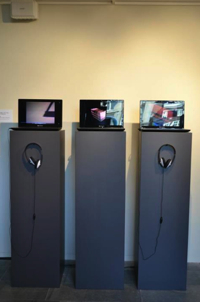
The original live performance of Painthouse took place at the Holland Festival in 1981 and was also broadcast on television. During the performance, the live and television audiences were given Toebosch’s point of view as she engaged with the space inside a rectangular wooden box. Toebosch’s paintings lined this environment and the audience heard her voice as she traced her brushstrokes. Toebosch’s sounds varied depending on the painting with which she engaged.
Painthouse was recreated at the Museum de Beyerd in Breda later in 1981, as was another recording. The work then appeared as a three-channel video installation in 1983. It consists of recordings from the Amsterdam and Breda performances as well as video taken of the box’s exterior. The three recordings played on monitors that are placed on top of pedestals. The recording of the box was placed between the two recordings of the live performances. This installation has exhibited within the Netherlands at NIMk in Amsterdam and the Nederlandse Videokunst in Middelburg as well as at Kunsthalle zu Kiel in Germany. It currently still exists as a three-channel video installation and last showed at NIMk in 2003.

Media Art Conservation and Restoration Workshop culminated in the students creating a conservation report for their work and presenting their findings at the Allard Pierson Museum on June 29th. The students also answered questions from a panel of three contemporary art professionals, including Wijers, Glenn Wharton of the Museum of Modern Art and lecturer at New York University, and Johannes Gfeller, Director of the Master’s program Preservation of New Media and Digital Information KNMDI at the State Academy of Fine Arts in Stuttgart.
Previous Post: Indiana University Posts 197 Educational Films
Next Post: Work Continues on a Film Trove in Jordan


